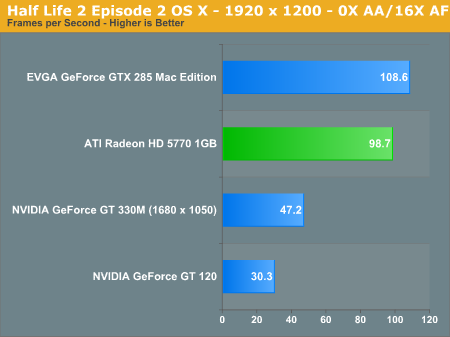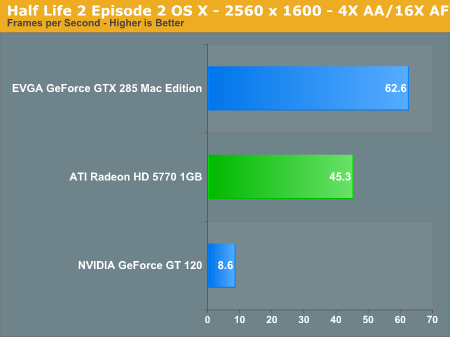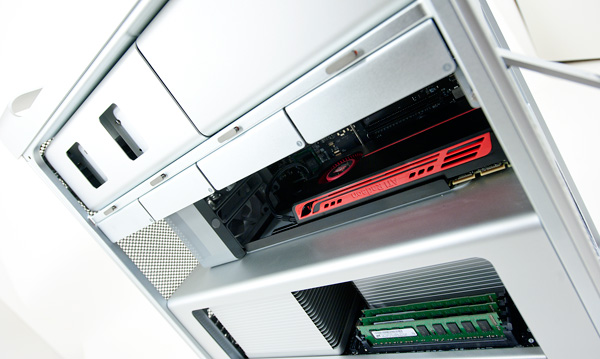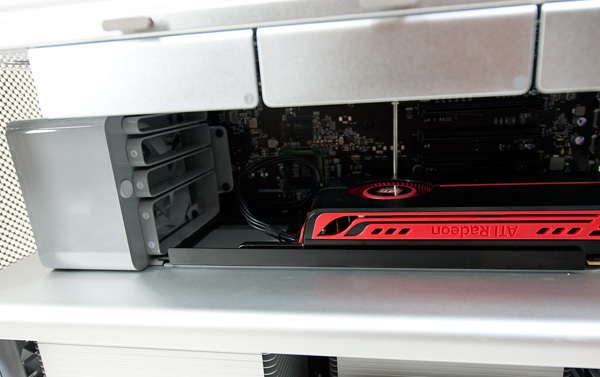Apple Mac Pro (Mid 2010) Review
by Anand Lal Shimpi on October 6, 2010 9:26 PM ESTNew GPUs
In one fell swoop Apple pulled NVIDIA out of almost all of its desktop products. With the exception of the Mac mini, every single Apple desktop uses an Intel CPU, an Intel chipset and an AMD GPU. To be fair though, Apple has alternated between NVIDIA and AMD for graphics every year for the past four years.
The GPU of choice in the Mac Pro is the Radeon HD 5770 equipped with 1GB of GDDR5. Clocked and spec'd identically to the PC version, this is the graphics card you get in all three standard models. For an extra $200 you can get a Radeon HD 5870 with 1GB of GDDR5, and for an extra $250 you can have two 5770s instead of one. Don't get too excited, the multi-GPU route is explicitly for more displays there's no concept of CrossFire under OS X at this point.
The Radeon HD 5770 is a huge step up from the GeForce GT 120 that previously came standard in the Mac Pro. The performance difference between the two is staggering! Where the 5770 does disappoint however is in comparison to EVGA's GeForce GTX 285 Mac Edition. It's slower.
I used Half Life 2 Episode 2 under OS X to get a general idea of gaming GPU performance. The improvement is huge compared to the old GeForce GT 120 that shipped in last year’s Mac Pro. Ultra high resolution frame rates improved by over 5x, while even 19x12 performance tripled.



If you’re curious about Starcraft 2 performance of the Radeon HD 5770 at 2560 x 1600, ultra quality settings, I saw an average frame rate of ~21 fps with a minimum at 17 fps and maximum at 27 fps. Note that this is in our CPU intensive battle test, so peak frame rates will be higher but if you’re doing a lot of unit management that’s pretty much what you can expect. In other words it’s not fast enough to play on a 30” at full resolution without feeling a bit choppy at times. To average above 30 fps you have to drop resolution and quality settings.
Display Outputs and Frame Buffer
The 5770 has three outputs in the form of two mini-DP and one dual-link DVI. The mini-DP ports can each drive a 27-inch LED Cinema Display while the DL-DVI port can drive a 30. This is a Radeon HD 5000 series card so you can actually have all three outputs active at the same time. That's right, with a single card you can drive three monitors. And with two, six monitors.
While 1GB of memory is enough to drive a single high resolution panel, it can be a stretch for two or three depending on what you're doing. As I've pointed out in the past you can have around 130 open Safari windows before you'll max out a video card with a 1GB frame buffer at 2560 x 1600. However, fire up Photoshop and open twenty 12MP images and you'll get the same effect. For heavy imaging work you'll still want more than one 5770 if you are going to drive multiple high resolution (2560 pixels wide) displays.
What would've been better is for Apple to offer a 2GB card, at least as an option, for very high end multi-monitor users.












84 Comments
View All Comments
Nardman - Friday, October 15, 2010 - link
^^This argument becomes valid the moment a Mac Pro can pull a doughnut.Cotak, handling is a tangible, quantifiable characteristic...
Apple products have sold for years based on the intangible 'worth' of them. What, exactly, makes the Mac Pro better than any other machine? That would be nothing...aside from a price tag, and marketing. Sorry, but that case is not worth $400(+)
mattgmann - Thursday, October 7, 2010 - link
I really can't understand the premium for these workstation class systems (apple or dell). There is basically a 100% mark up or more on parts. I'm sure a large business may be able to afford to just chuck money at systems, but any small business/independent designer is freaking retarded to buy a system like this. With a little shopping and a few hours of construction you can have a FAR superior system for half the price. Aside from being able to get free performance by overclocking your CPU, you can build a storage system that is quick and redundant (i.e. raid 5). Save your money for the adobe raping you'll receive every time they release a new CSX.BrooksT - Thursday, October 7, 2010 - link
Read up on fixed costs, variable costs, and overhead.Short version: these workstations sell in much lower volume than mass market machines. Yet some of the fixed costs -- R&D, design, certifications, etc -- are exactly the same, or higher. They have to spread higher costs among fewer machines, resulting in higher gross margins per machine.
Think of an extreme: if Apple (or Dell, or anyone) were going to produce just one workstation of a certain type -- only one unit made with a particular case, power supply, documentation, marketing effort, warranty service, spare parts inventory, customer support, UL certification, etc -- how much would it cost at retail, compared to the raw parts cost? A lot, right?
mattgmann - Thursday, October 7, 2010 - link
How long does it take an "engineer" to compile a parts list, and a minimum wage factory worker to slap together off the shelf components that are the equivalent of adult legos. Overhead cost is greatly exaggerated in these machines and they inflate the cost solely because the customers are "professionals".
'documentation, marketing effort, customer support etc'. These are all things that apply to every system they make and the costs are no different. I think these are more apologistic excuses rather than actual reasons.
how much would it cost at retail, compared to the raw parts cost? A lot, right?
-not really. If you think Dell and Apple are paying retail for the parts in those systems, you're crazy. They're making retail markup to start with, and then many times that amount for putting the system together.
Is this wrong? no. of course not. But these types of systems are where they make large profit margins, and there is a lot of money to be saved by doing it yourself, or even paying an individual to do it for you.
Swissalex - Thursday, October 7, 2010 - link
You are missing out on a big point, the certification for the professional application like AutoCAD and so on.The Dell Precision line comes with a complete support for many of these professional applications. And if this is your primary work tool you are not interested in troubleshooting and tweaking your system. Productivity and stability is more important.
I am not Apple expert; on the Dell website they make it very clear that they support those applications. I have not found the same for Apple. Do they offer the same level of support for software?
Swissalex - Thursday, October 7, 2010 - link
Also what is the support level on the Mac? Dell comes with a 3 year NBD service by default. There is no information on the price comparison about this one.Penti - Thursday, October 7, 2010 - link
The Mac Pros more tend to be used by the post-processing guys in Film (And TV) when it comes to high-end. Tools like Apples quicktime, and FCP becomes really important there. Together with very important third party tools. It works as well as in the Windows world, but they also has some tools that don't really exist on Windows. Where the alternative would be specialized hardware and a separate workstation that's built with custom hardware and software from a vendor in that business. Obviously Apple do and would help a vendor who's having a problem with their software, but they won't issue fixes like reverting stuff just for some app to work, but neither would Microsoft. It's up the the software vendor to support it. Like always. It's not that Dell can start doing development on the workstation graphics cards drivers.As for warranty the standard is 1 year limited even with the Mac Pro.
BrooksT, if you like a more competitive price look at Apple 2P workstation.
MGSsancho - Friday, October 8, 2010 - link
Right tools for the right job. even if you use Avid you can use either system. but in practice when shops use Fiber Channel interconnects, dual 30" screens, mixing boards and professional video (SDI) and audio (XLR) interconnects, things are not so PC vs Mac. While im sure that these $30k+ workstations don't care too much for the OS they use, these things are more like appliances. In other industries as well, maybe all your software tools, scripts, plug-ins and stuff can not be easily ported. Companies spend good money setting up these workstations and they don't care what OS they use, they have the tools they like and want results. Penti you pretty much nailed it all on the head. except with Microsoft they will write patches to get things working for you as well as the Unixes, granted those with the top level up support contracts.Real difference is the support contracts. Apple doe not yet have business support plans. no four hour support for mission critical stuff for people who want to pay for it. In the end, we must hope that businesses will get the best tools for their jobs.
rafaperez3d - Friday, October 8, 2010 - link
It's a shame where the video and tv market is going because this company. To get the job done we need two things: reliability and performance. After a lot (a loooot) of marketing, Apple put in people heads that they got those two things, far ahead from any PC. We know that is not true (Anand proved a few pages back), and the market is supporting those silly people. Please, don't tell me about high reliability on Macs. I crash Foundrys Nuke at least 12 times a day, Final Cut every single hour, Blackmagic cards give me sync and black frames time to time, Cinema 4D crashes a lot too, coworkers restarts their machines time to time... OS X is not bad, but is not perfect too.Penti - Saturday, October 9, 2010 - link
I guess you would prefer having Windows workstations, Linux workstations, OS X workstations and specialized workstations instead? In a mixture. OS X and Mac pro is a good target for the guys who ran their apps on Unix/Irix/Linux. It's good, not perfect. On Linux for example you don't have access to anything like quicktime, the film people won't start running ffmpeg, plenty in the business seems to prefer having less workstations and workstations that can do more. But for it to be working perfect? I wouldn't expect that anywhere. But you should note that I didn't make any claim for reliability, it's the same hardware as in the PC workstations, not any higher quality and not some perfect software solutions. Not from Apple neither from the third parties. Which is actually what I implied as in the support not being perfect. They do tend to support that market but not perfectly and neither does any one else. I see Apple as an OEM mainly.